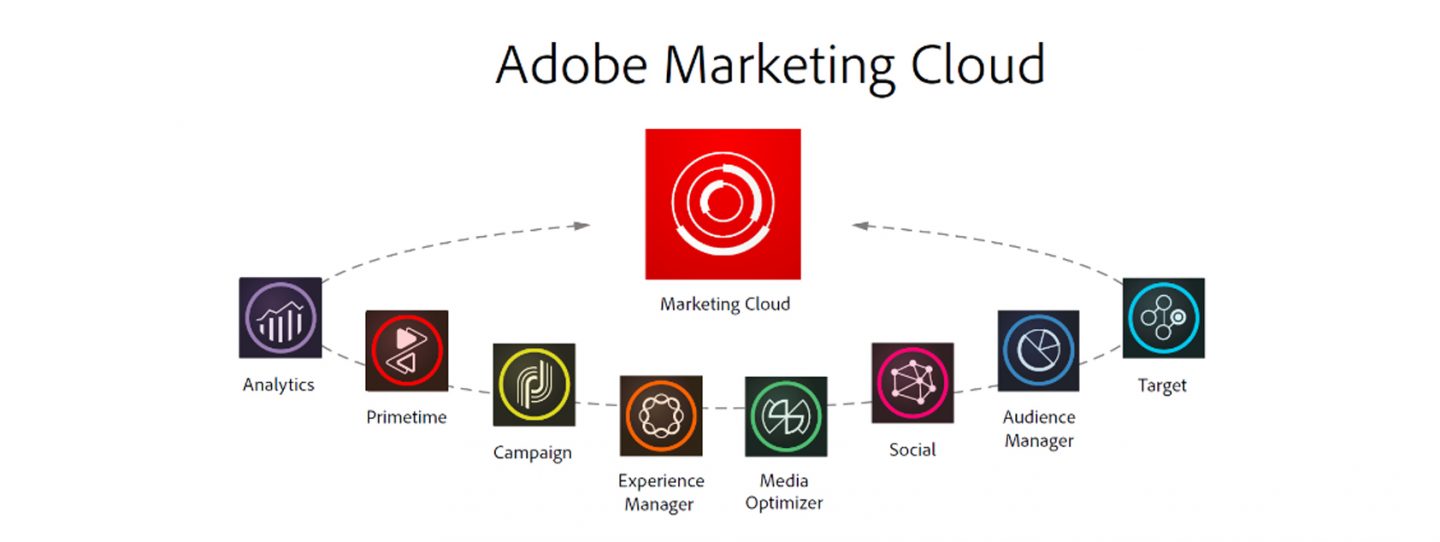Blogs

Marketing professionals have to speak the language of their customers. In order to reach them, they have to deliver the right content through the right channels to the right devices and provide a personalized experience. To achieve this, marketers need to quantify facts with relevant data.
Your online presence must be consistent across devices, channels and languages to offer a connected experience. To achieve this, digital marketers need to efficiently manage and measure their social marketing activities and optimize their marketing expend on certain display.
So, is there an all-in-one digital marketing solution to help you crush your goals?
Fortunately, there is… the Adobe Marketing Cloud
Leveraging the eight solutions offered by Adobe Marketing Cloud, marketers can comfortably master their digital marketing problems.
Let’s explore more about each of these solutions.
Adobe Experience Manager
It is quite difficult to understand demands and meet the expectations of every single customer. They expect enterprises to provide relevant content on all devices. Also, they are constantly and quickly switching from one digital device to another. Whether they are shopping on your e-commerce website through their desktop, scrolling through your mobile app on their smartphones or visiting your store, they want all the digital experiences to seamlessly connect together.
So it’s important for brands to think about how to deliver consistent and continuous experience across all channels and devices. You have to enable your customer to continue where they left off even when they’re swapping between touchpoints.
Another important activity of marketers is managing several websites. This is quite a challenge because your website should adapt to multiple devices and languages.
If your assets aren’t well organised, the content will be inconsistent and irrelevant to the customer’s web experience. You need an enterprise content management system that lets you easily optimize your websites and tie in your social platforms.
Enter the Savior, Adobe experience Manager!
Adobe Experience Manager helps you efficiently create, manage, deliver and optimize content and experience. This Adobe solution provides a web content management system featuring a multilingual what you see is what you get (WYSISYG) mode. With this powerful CMS, you can easily manage multiple websites, applications and digital publications.
AEM has 5 components:
- Sites
- Assets
- Apps
- Forms
- Communities
Each of these have a critical role to play in making your brand journey delightful and building a comprehensive digital strategy.
Adobe Analytics
People visiting your site have different intentions. Some are there to buy stuff, some are simply researching products, and some might even be looking for a job. Then, you have your first-time visitors and returning visitors. Some segment of your visitors don’t know why they’re there in the first place and just want to get out.
Yet, most websites and landing pages display exactly the same content to all visitors – no matter what they’re searching for or how they got there in the first place. These websites try to appeal to a wide range of visitors simultaneously, and thus fail to really excite the potential buyers.
Wouldn’t it be awesome to display personalized content and call-to-actions for different types of visitors? Essentially making your visitors feel like the page speaks their language?
Well there is a grounded, leading solution named Adobe Analytics that provides digital marketers with one place to measure, analyze and optimize integrated data from all online initiatives across multiple marketing channels.
It provides marketers with actionable, real-time web analytics intelligence about digital strategies and marketing initiatives.
It works by looking at the data which is provided by analytics about the visitor – things like location, keywords they searched for, ads they clicked, whether they’ve been to the site before and also data like buying history – and compares that against a set of variables that you have put in place. It lets you target relevant content to different types or groups of visitors based on their behavior or other variables.
Those variables could include:
- Location – city, country, region
- Device – iPhone, iPad, Android phone/tablet, Windows, Mac, Linux
- Search keywords
- Visitor frequency – First, second, third, fifth time visitor?
- Date and time of day, proximity to payday
- Referring URL – where did they come from?
- Customer history – have bought before, what they bought, how much did it cost?
- Sessions behavior – navigation clicks, page views
There are many more variables which can be taken into account like age, gender, etc. The possibilities are pretty much endless and it depends a lot on how much info you already have about your customer.
Adobe Target
In this competitive era of digital marketing, every visitor on your website can never be a customer. Every marketing professional wants to communicate well with their visitors by extracting their needs and personalized interest. Every customer expects a unique experience and personalized offers rather than a one-sided or automated communication from a website. In order to fulfil those expectations, a marketer requires an effective plan to get an optimum amount of marketing expenditure so as to offer a limited number of discount on stuff.
Adobe Target analyzes customer wishes and demands through the data generated by Adobe Analytics. This helps to deliver relevant content and tightly integrate with Adobe Social for enhanced social marketing. Now you can deliver the ads or promotions of the right products to the right targeted customers. This kind of automated behavioral targeting imparts an exponential growth in number of customers.
Also it helps to dynamically create content based on the visitor’s profile and to suggest targeted recommendations to the user even before they finish typing out their search queries. External data sources like order history can also be integrated to analyze visitor profile which further helps in optimized merchandising and offering discount on the targeted stuff. This dynamic navigation guarantees a perfect on-site experience.
Adobe Campaign
It is very important to reach out to your customers in meaningful ways.
With Adobe Campaign you are able to integrate and deliver one-to-one campaign so all the customers get relevant and consistent experience across online and offline channels.
We understand each customer through their integrated profile, which is made up of the purchasing history, social interactions, their location and other information gathered by Analytics and pulled into Adobe Campaign.
Adobe Campaign uses this analytics data to create personalized campaigns according to the customers interest.
Reports in adobe campaign show you how things are going, you can see who is responding to your offers, how much revenue your campaigns is generating.
With adobe campaign you have a deep real time understanding of your customers so you can design, integrate and automate cross channel experiences and measure the success. All for one solution.
Adobe Social
Social media managers are responsible for increasing brand reach and audience engagement through social platforms and creating a consistent brand experience across channels and devices.
They must also ensure the right message gets through all the noise of social traffic to the right customers and you need to respond to customer issues that arise via social platforms. All the while you must also connect all these social efforts to measurable business results.
How can one possibly monitor, manage and measure so many social media channels and also quantify the business value of social marketing?
Easy! All you need is Adobe Social.
Adobe social enables marketers to scale social activities across the organization; create and deliver relevant, engaging content across all social properties; capture and analyze all key sources of meaningful social data alongside integrated conversion metrics; leverage data to demonstrate social value and optimize interactions; and manage and strengthen customer relationships across social channels – all from one integrated platform.
Adobe Audience Manager
What problems are we trying to solve with Audience Manager?
Marketers have multiple database and technologies that they use to solve personalization across each channels.
There are lot of technologies, and customers can be on web, mobile, email or social. The challenge here is that the database touches into multiple channels. Marketers here really didn’t have a coherent or a relevant conversation as a consumer moves across multiple touchpoints. And this is the reason for disjoint experiences.
And this is something that can be address by a Data Management Platform (DMP).
A DMP or Audience Manager (in the case of Adobe) consolidates audience information from all available sources. It identifies, quantifies and optimizes high value target audiences which can then be offered to advertisers via an integrated, secure, privacy-friendly management system that works across all advertising distribution platforms.
DMP comprises 4 key parts:
- Collect Data – Collect data and allow it to sit in a single repository.
- Unify Data to a profile – DMP can take this data from the different sources and tie that data back to a profile.
- Create Audiences – In DMP, you can take the various profile information that you need to create audiences and audience segments.
- Push to Marketing platforms: Value you create through these segments is the capability to reach the people who follow the segments.
Adobe Media Optimiser
Once building a great website is done, it is time think about the MOOLAH!
Marketers really need to get a larger return on their ad spend to engage more relevant audiences, derive brand awareness and generate revenue.
But how should one distribute their media budget between display, search and social?
What is the most profitable way to run a cross-channel advertising campaign?
Advertisers are trying to simplify their lives, they are trying to have more control over right campaigns and their budgets and trying to be more efficient with their ad buys.
With Adobe Media Optimiser, we can answer all these questions easily and get maximum return on investments.
Using mathematical models and industry leading algorithm, Adobe Media Optimiser evaluates the situation which enables you to adjust your strategies, goals and budget in real time.
It also provides precise forecast based on our goals and predicts the best channels mix for his budget.
With Adobe Optimiser, marketers can manages all of their campaigns for every platform. Search engines like Google & Bing. Social platforms like Facebook and Twitter.
So, marketers can always rely on peak conversions and the right investments.
The right messages to right people at the right time
Finally, not only traffic on websites will increase but the revenue will also grow profitably.
Adobe Primetime
The way people watch TV and video has evolved.
You need to personalize and then individualize the viewing experience constantly.
Users want to jump in and enjoy shows only when you offer them a fully immersive experience. This means making it easy for each viewer to securely stream their desired TV shows, sports programs and films in high definition across different screens wherever and whenever they want to.
Adobe Primetime, part of the Adobe Marketing Cloud, helps deliver engaging experiences for viewers to amass more subscribers and revenue from advertising and subscription.
Now it’s possible to create engaging experiences on every device using Primetime.
Primetime allows you to deliver the right ads to the right audience to improve the effectiveness of your ad sells.
Conclusion
We all know that the key to mastering customer experience (CX) is knowing the customer and for this Adobe Marketing cloud is the perfect fit. My vote goes for Adobe Marketing cloud.
What about you?
Credits: Adobe Sites










